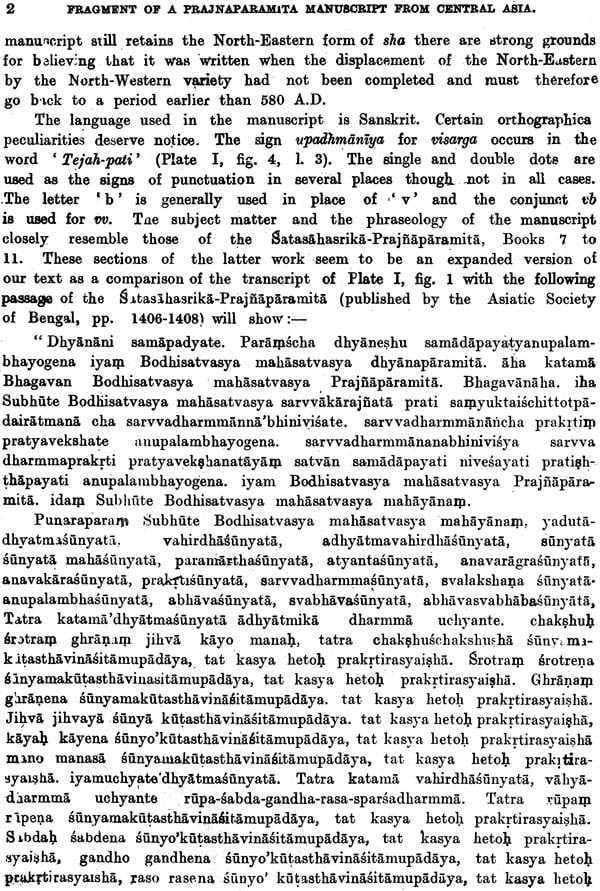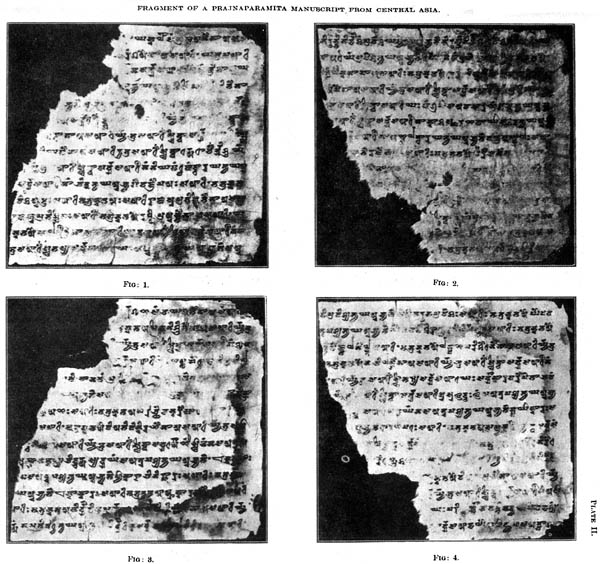
Fragment of A Prajnaparamita Manuscript from Central Asia
Book Specification
| Item Code: | NAL878 |
| Author: | Pandit B. B. Bidyabinod |
| Publisher: | Archaeological Survey of India |
| Language: | English |
| Edition: | 1998 |
| Pages: | 28 (16 B/W Illustrations) |
| Cover: | Hardcover |
| Other Details | 11.0 inch X 9.0 inch |
| Weight | 330 gm |
Book Description
The manuscript fragment dealt with in this issue of the memoirs was received by the Director General Archaeology in India from the political Agent, Gilgit, in 1906, and lent to the Indian Museum for exhibition n 1916. The leaves of the fragment adhered to each other. Mr. Sanaullah, the Archaeological Chemist in India, to whom it was made over for treatment, succeeded in separating the leaves and put each between two sheets of glass for preservation. The fragment consisted of 48 leaves of dun - coloured paper varying in size. The largest of the leaves measures 10” x 9 ¼ ” and of these eight leaves are in a tolerable state of preservation and have, therefore, been selected for publication. They bear writing on both sides and each page contains fourteen lines. On an average the aksharas measure ¼” to ½ “ in height. The leaves are not perfect, for instance line 4 of plate III, fig. 4 reads…shtih samyak – samkalpam samyag - vak samyak –karmmantah samyag-ajwam samyagvya and line 3 ends with punarapa, so line 4 must have had some such words as these in the beginning – [ram… Yaduta - ryya-shtango margah samyak dri ] shtih, and line 5 undoubtedly had in the beginning yamah samyak smritih samyak samadhih Bodhi – It is therefore evident that a third part of the longer lines and larger part of the shorter lines of each page from the beginning have disappeared. A considerable number of letters on some of the pages have become more or less illegible owing to the link having been rubbed off.
The characters belong to the upright Gupta of the calligraphic type. The peculiar features of this alphabet have been carefully noted by Professor Luders in his introduction to the fragment of Saddharmma- Pundarika included in Hoernle’s Manuscript Remains of Buddhist literature found in Eastern Turkestan, (Oxford, 1916). The upright Gupta alphabet used in the Khotanese manuscripts corresponds to the Indian North-Eastern variety of the Gupta alphabet. According to Dr. Hoernle the displacement of the North-Eastern variety by the North-Western variety of the Gupta alphabet must have begun very early and completed by about 580 A. D.1 As the present Manuscript still retains the North-Eastern from of sha there are strong grounds for believing that it was written when the displacement of the North-Eastern by the North-Western variety had not been completed and must therefore go back to a period than 580 A.D.
The language used in the manuscript is Sanskrit. Certain orthographica peculiarities deserve notice. The sigh upadhmamya for visarga occurs in the word ‘Tejah-pati’ (Plate I, fig. 4, 1. 3). The single and double dots are used as the signs of punctuation in several places though not in all cases.
The letter ‘b’ is generally used in place of ‘v’ and the conjunct vb is used for vv. The subject matter and the phraseology of the manuscript closely resemble those of the Satasahasrik - Prajnaparamita, Books 7 to 11. These sections of the latter work seem to be an expanded version of our text as a comparison of the transcripts of plate I, fig. 1 with the following passage of the Satasahasrika - Prajnaparamita (published by the Asiatic Society of Bengal, pp. 1406-1408) will show:-
“Dhyanani samapadyate. Paramscha dhyaneshu samadapayatyanupalam – bhayogena iyam Bodhisatvasya mahasatvasya dhyanaparamita. aha katama Bhagavan Bodhisatvasya mahasatvasya Prajnaparamita. Bhagavanaha. iha Subhute Bodhisatvasya mahasatvasya sarvvakarajnata prati samyuktaischittotpa – dairatmana cha sarvvadharmmanna bhinivisate. sarvvadharmmanancha prakrtim pratyavekshate anupalambhayogena. sarvvadharmmananbhinivisya sarvva dharmmaprakti pratyavekshanatayam satvan samadapayati nivesayati pratish – thapayati anupalamabhayogena. iyam Bodhisatvasya mahasatvasya Prajnapara – mita. idam Subhute Bodhisatvasya mahasatvasya mahayanam.
Punaraparam Subhute Bodhisatvasya mahasatvasya mahayanam, yaduta – dhyatmasunyata, vahirdhasunyata, adhyatmavahirdhasunyata, sunyata sunyata mahasunyata, paramarthasunyata, atyantasunyata, anavargrasunyata, anavakarasunyata, prakrtisunyata, sarvvadharmmasunyata, svalakshana sunyata, anupalambhasunyata abhavasunyata, svabhavasunyata, abhavasvabhabasunyata, Tatra katama’ dhyatmasunyata adhyatmika dharmma uchyante. chakshuh srotram ghranam jihva kayo manah, tatra chakshuschakshusha sunyama – katasthavinasitamupadaya. tat kasya hetoh prakrtirasyaisha. Srotram srotrena sanyamakutasthavinasitamupadaya, tat kasya hetoh prakrtirasyaisha. Ghranam ghranena sunyamakutasthavinasitamupadaya. tat kasya hetoh prakrtirasyaisha. Jihva jihvaya sunya kutasthavinasitamupadaya. tat kasya hetoh prakrtirasyaisha, Kayah kayena sunyo’ kutasthavinasitamupadaya, tat kasya hetoh prakrtirasyaisha mano manasa sunyamakutasthavinasitamupadaya, tat kasya hetoh prakatirasyaisha. Iyamuchyate dhyatmasunyata. Tatra katama vahirdhasunyata, vahyadharamma ucyante rupa – sabda – gandha – rasa - sparasdharmma. Tatra rupam rapena sunyamakutasthavinasitamupadaya, tat kasya hetoh prakrtirasyaisha. Sabdah sabdena sunyo’ kutasthavinasitamupadaya, tat kasya hetoh prakrtirasyaisha, gandho gandhena sunyo’ kutasthavinasitamupadaya, tat kasya hetoh prakrtirasyaisha, raso rasena sunyo’ kutasthavinasitamupadaya, tat kasya hetoh prakrtirasyaisha, sparsah sprasena sunyo’ kutasthavinasitamupadaya, tat kasya hetoh prakrtirasyaisha. dharmadharmaih sunya akutashavinasitamupadaya tat kasya hetoh prakrtirasyaisha, iyamuchyate vahirdha sunyata. Tatra katama’ – dhyatmavahirddhasunyata, sahadhyamilkanyayatanani ime uchyante adhyat – mikavahyadharmah, tara’ dhyatmika dharma vahyadharmiha sunyah akutas – thavinasitamupadaya, tat kasya hetoh prakrtirasyaisha. ime vahya dharmah adhyatmikaih dharmaih sunyah akutashavinasitamupadaya, tat kasya hetoh prakrtirasyaisha, iyamuchyate adhyatmavahirddha sunyata.
| Introduction | 1 |
| Transcript | 4 |
| Index | 13 |
| Plates | I-IV |









